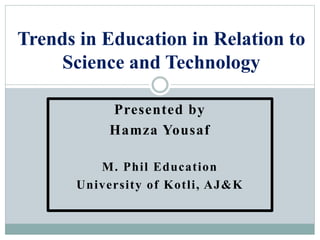
Trends in Education in Relation to Science and Technology
- 1. Presented by Hamza Yousaf M. Phil Education University of Kotli, AJ&K Trends in Education in Relation to Science and Technology
- 2. Trends in Education Relation to Technology Educational Technology Educational Technology is simply the process of integrating technology into education to build better teaching/learning experiences that result in higher learning outcomes.
- 3. Conti… The last few years have witnessed a dramatic change in the learning model. The way students are being taught today is very different from the teaching methods that were adopted a few decades back. Technology has brought about various changes in the way education is delivered and received.
- 4. Top Current Trends in Educational Technology E-learning E-Learning is education or training delivered electronically. It can be slide-based online activities, or it can also be an online course. In E-learning educational content is delivered to learners through computers, laptops, tablets, or smartphones. Variety is the outstanding feature of online learning platforms. Live stream or group meetings using Zoom or Microsoft Teams, recorded lessons. A good platform is LMS.
- 5. Conti… Video Assisted Learning Video-assisted learning (VAL) is defined as a strategic teaching approach to using videos – either educational or conceptual – to improve a student’s comprehension, cognitive ability, or social-emotional skills. Videos, educational videos, animated videos, documentaries, moral storytelling or demonstrations of practical life skills. Free educational videos platforms; Edutube, Teachfind, Brightstorm and Khan Academy
- 6. Conti… Artificial Intelligence The ability of a computer or a robot controlled by a computer to do tasks that are usually done by humans because they require human intelligence. Plagiarism detection, learning management systems, grading the students,
- 7. Conti… Data Management and Analytics Managing data has become ever so convenient and important with the advent of technology in education system. Teachers’ can now complete analytics of student’s performance, such as number of tests attempted, chapter completed. Assigning and evaluating the assignments, Complete record of all the students of school.
- 8. Conti… Collaborative learning In classroom teachers encourage collaboration by assigning group activities and tasks. Today technology has bridged the gap between teachers and students. It helps students to develop their interpersonal skills.
- 9. Conti… Immersive learning with AR and VR Learning has become much more interactive than traditional methods. While VR provides a constructed reality, AR gives an enhanced view of a real image.
- 11. Conti… Gamification in Education Gamification increases level of engagement in classrooms. There is no reason for students not to be actively involved in classroom games. . Gaming elements help create a funny and positive learning environment for learners. The adoption of gamification is most popular in the K-12 education sector. Platforms; Quizlet, Kickstarter, ClassDojo.
- 12. Conti… Social Media in Learning Many educational institutes have started using social media as a communication tool in which students can interact with others easily. . Students can share study materials, discuss with others in a group, or easily comment on someone else’s post. Educational videos on YouTube.
- 13. Trends in Education in Relation to Science Audio Visual Teaching Aids Slide Projector Based teaching Student Centered Research in Science Education High Impact Factor Analytical Thinking
- 14. Conti… Problem solving More Focus on Formative Assessment